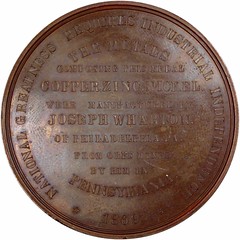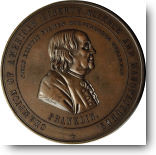
PREV ARTICLE
NEXT ARTICLE
FULL ISSUE
PREV FULL ISSUE
JOSEPH WHARTON PARENTS MEDAL PROVES ELUSIVE
It's not often our readers are stumped. But Sam Winikor's Wharton medal pictured last week has proved a tough target. It turns
out we've asked about this one before, in a 2010 article by Jonathan Brecher. Thanks to Jonathan and Pete Smith for pointing it out.
I'll republish that query here to refresh our memories. Can anyone add anything new about this piece? Thanks. -Editor
Joseph Wharton was a major 19th century industrialist credited with producing the first metallic zinc and the first metallic nickel in America. He was also was one of the founders of both the International Nickel Co. and Bethlehem Steel. He also founded the Wharton School of Business at the University of Pennsylvania.
Attached are pictures of a different medal related to Joseph Wharton, showing his parents William Wharton and Deborah Fisher Wharton. It is 53.4 mm, 54.9 g, and unsigned. I have not been able to locate any information about this medal, and I wonder if any of the readership might have seen it before.
The wording on the reverse is identical to this one, but from a totally different die. Compared to the Franklin medal, parts of the William Wharton medal show high quality. The letters are nicely squared off, and it clearly had nice reflective surfaces to start with. But parts have low quality. Many of the letters on the reverse of the William Wharton medal are recut or repunched, some of them drastically. The portraits show linear dotted marks throughout that I'm going to say (waving my hands) might be un-cleaned-up evidence of using some sort of reducing machine during the production of the dies. In short, the William and Deborah Wharton medal doesn't have the feel of "Lovett quality".  
In trying to find any information about this medal, I came across one reference that might be relevant -- or that might confuse the issue further. On February 18, 1895, Horatio Robinson Storer read a paper before the Newport Historical Society describing the medals of Rhode Island. Item 120 in that paper is a medal described as "Joseph Wharton, summer resident at Jamestown, R.I. Bronze. 53mm. By R. Lovett." . That medal is probably related to this one, but is it the same piece? It seems that this medal would best be described as portraying William and Deborah Wharton. Similarly, the Franklin medal would best be described as portraying Franklin. Was Storer describing one of those, or possibly a third piece that really does portray Joseph? Any information about this William and Deborah Wharton medal would be welcomed. Pete Smith writes: The Wharton medal with Franklin on the obverse was listed with other Franklin medals in the American Journal of Numismatics, volume VII, number 3, January 1873. This was just nine years after its issue date of 1864. An example was sold with the Fonrobert collection by Adolph Weyl in 1878. Thus it is well established in numismatic literature and has been included in subsequent listings of Franklin medals. I am intrigued by the legends. On the obverse it says referring to Franklin, “CHAMPION OF AMERICAN LIBERTY, SCIENCE AND MANUFACTURES.” On the reverse, “NATIONAL GREATNESS REQUIRES INDUSTRIAL INDEPENDENCE.” It could just as well have said, “LIBERTY PARENT OF SCIENCE AND INDUSTRY.” On the medal Wharton was promoting his business producing copper, zinc, and nickel, and asking for freedom to produce without interference from the government. Wharton opened his American Nickel Works in Camden, New Jersey in 1863, and he was the primary American source for nickel. By 1864 he had a thriving business as the country consumed bronze in the war efforts. The medal date was altered to 1869 and more pieces were struck. By then Wharton was promoting his nickel for American coinage. The medal featuring his parents is not well documented in numismatic literature. The reverse die has the same text and layout as the Franklin reverse but is clearly a different die. While Robert Lovett produced the original dies, Wharton went to someone else for these dies. Medals may provide a record of people and events in history. In this case, the medals have survived, but no paper records have been found to clarify their purpose, their maker, or the number produced. Several works have been published on the medals of Franklin. The other medal awaits publication of a book on medals of parents of industrialists.
Thanks. Can anyone add anything else about this piece? -Editor
To read the earlier E-Sylum articles, see:
Wayne Homren, Editor The Numismatic Bibliomania Society is a non-profit organization promoting numismatic literature. See our web site at coinbooks.org. To submit items for publication in The E-Sylum, write to the Editor at this address: whomren@gmail.com To subscribe go to: https://my.binhost.com/lists/listinfo/esylum All Rights Reserved. NBS Home Page Contact the NBS webmaster 
|

